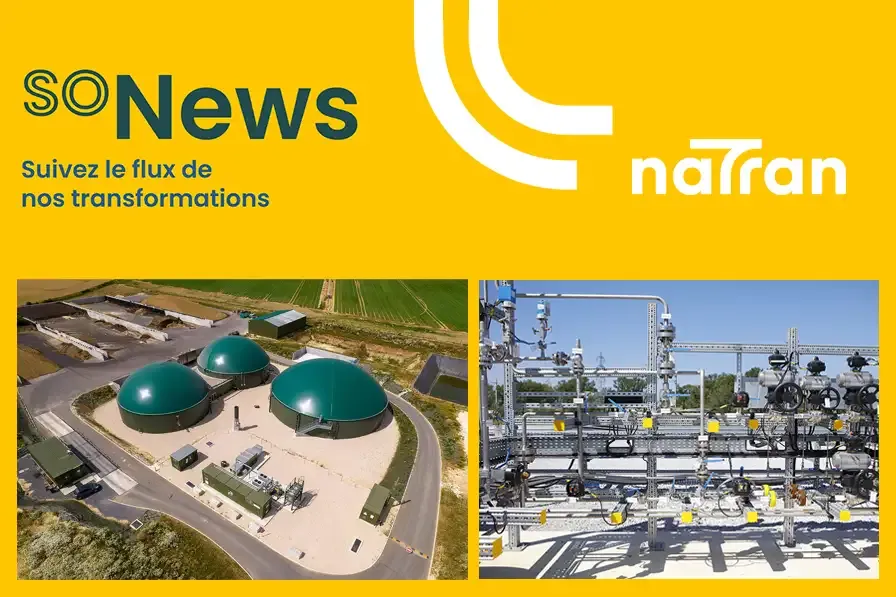Contents of the June 2025 soNews blogletter

On the soNews agenda for June 2025: France’s national hydrogen strategy, the 2024 Renewable Gas Overview, Jupiter 1000, hydrothermal gasification, and more!
In soNews today
The recently published National Strategy for Low-Carbon Hydrogen has set the course for the French sector, confirming the role of low-carbon hydrogen in the energy transition. NaTran is pleased to see that the foundations for regulating hydrogen infrastructures and the hydrogen market have been laid down in this document, where the role of transport and storage infrastructures is recognised for the first time. Both of these aspects will be essential for connecting all producers to consumers. The government’s stated priority – a 500 km transmission network by 2030 – is primarily focused on deploying transmission infrastructures at industrial hubs and connecting them to storage sites. The projects initiated by NaTran are part of this trajectory and are in line with the consultation process currently being led by NaTran involving all stakeholders and participants in the H2, CO2 and CH4 markets.
While France’s national strategy favours production on French soil initially, it also specifies that a European hydrogen transmission network could be developed in the longer term. This is consistent with the joint declaration made by French President Emmanuel Macron and the new German Chancellor Friedrich Merz, confirming a desire to invest effectively in the main networks, particularly cross-border energy infrastructure.
The 10th Renewable Gas Overview published by SER confirms that France is well on the way to decarbonising its gas industry by 2030. In fact, this is the ambition set out by France in its National Low-Carbon Strategy and its projected Multiannual Energy Plan. While the renewable gas industry welcomes the target of 44TWh HHV of biomethane injected into the grid by 2030, it notes that the bracket announced for 2035 (44 to 79TWh HHV) promises to be more ambitious. To send the right signal to those involved in its sector, it is requesting that ‘a stable course be set’ through public financial and regulatory support capable of accelerating the production of renewable gas for years to come. The stakes are high: guaranteeing both decarbonisation and the country’s energy sovereignty.
Jupiter 1000 – France’s first industrial Power-to-Gas demonstrator, which was launched in 2016 in Fos-sur-Mer (Bouches-du-Rhône) under the aegis of NaTran – transforms surplus renewable electricity into hydrogen and/or synthetic methane, paving the way for storing renewable electricity in the form of renewable gas that can be injected into the gas transmission network. After successfully concluding its first test phase in 2024, the site will be writing a new page in its history by embracing new collaborations. NaTran R&I has launched a Call for Expressions of Interest (EOI) from companies, researchers, institutions and project leaders with a view to developing synergies in the hydrogen, CO2 and synthetic fuels sectors. Interested? Be quick! Applications must be submitted before 23rd June!
Excellent news for hydrothermal gasification: SUEZ and the CNRS have signed a five-year framework agreement to further research into sustainable water and waste management. For the past 10 years, the two institutions have been working on the development of a unique hydrothermal gasification (HG) unit capable of using wastewater sludge to produce renewable gas, recovering the minerals present in the sludge and destroying certain micropollutants, including PFAS, which are highly persistent and toxic chemical pollutants. An industrial pilot will be set up in Gironde. NaTran, the driving force behind hydrothermal gasification in France who initiated the Call for Expressions of Interest in 2024, welcomed this progress: “Today, there are over fifty players across the value chain working towards the same goal: to successfully implement the first industrial projects in France by 2028,” states Robert Muhlke, HG Product Director at NaTran.
- 11.6 TWh
The quantity of biomethane injected into the networks in 2024, which represents an increase of 27% on 2023 (9.1 TWh). This is equivalent to the consumption of around 756,000 homes or 40,000 lorries/buses, confirming that biogas is increasingly prevalent in the French energy mix. - 150
The number of work-study students that NaTran hopes to recruit in 2025 across all professions: R&D, operations, management, engineering, innovation, etc. The common denominator? A desire to contribute to the energy of the future. Spread the word!
On 25th September, gas industry leaders including NaTran, decision-makers and start-ups will be meeting in Paris to discuss the latest developments and the future of the gas industry on the theme: “Focus on 2030: ensuring a competitive transition”.